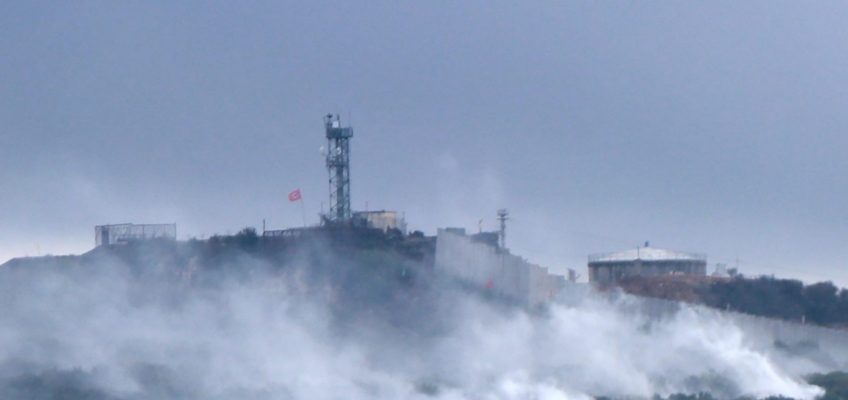Israel is scrambling GPS signals over most of its northern airspace to protect itself from Hezbollah missile strikes — potentially endangering Israeli civilians and commercial aircraft in the process.
A group of researchers at the University of Texas at Austin who have tracked GPS signals in the region for years noticed a strange pattern emerging after the Hamas militant group’s surprise attack on Oct. 7: Planes flying near the Mediterranean sea briefly disappeared from sight over many parts of Israel.
That’s a sign of “GPS spoofing,” a technique in which the location of an airplane — or precision-guided missile — or any object that uses GPS is rendered inaccurate.
“This is the most sustained and clear indication of spoofing I’ve ever seen” and affects potentially hundreds of large commercial airplanes, said Todd Humphreys, a professor at UTexas. His graduate student, Zach Clements, first discovered the spoofing pattern.
Pilots on those planes use GPS as one of their key navigation tools, optimizing flight routes, reducing fuel usage and helping with landing among other important functions. A spoofing incident over Iraq and Iran in September almost caused a business jet to fly into Iranian airspace without clearance.
Missiles that use GPS could also be thrown off their trajectory, making it hard to predict where in Israeli territory they would land. That could pose additional risk to civilians from missiles meant for military targets.
The Israel Defense Forces announced on Oct. 15 that GPS had been “restricted in active combat zones in accordance with various operational needs,” but did not note the extent of the signal disruptions.
Citizens near Israel’s border should stay near protected zones, the statement said, and Israelis should also expect “temporary glitches in location-based applications” like Google Maps.
Clements said Israel also issued a warning to pilots landing in the country that they shouldn’t rely on GPS to land, instead relying on other methods onboard to do so. The IDF didn’t respond to questions about the matter aside from pointing to previous statements.
The danger of missile strikes is a real one. Lebanon-based military group Hezbollah, which is backed by Iran and sympathetic to Hamas, has a massive arsenal of rockets, including precision-guided missiles. The group has already attacked Israeli forces near the border with rockets, but fighting in the area has remained relatively small-scale. The militant group has yet to fire its long-range missiles at Israeli targets, which could escalate the conflict.
The Biden administration has discussed options it could take if Hezbollah becomes more entrenched in the war, including using U.S. military force against the group.
But Hezbollah’s recent actions suggest that the group, at least for now, doesn’t want to escalate.
The group has been “lobbing unguided rockets — yes, those cause destruction, they may hit residential areas,” said Shaan Shaikh, associate director of the Missile Defense Project at the Center for Strategic and International Studies. But they’re “not being used to strike certain critical military assets or infrastructure or very high civilian territories.”
Hezbollah has the capabilities to conduct strikes deep inside Israel, but “they know that if they start launching larger, more accurate missiles at critical targets, that Israel will increase its retaliation,” Shaikh said.
Fighting between Israel and Hezbollah continued on Saturday, with Israel killing six of the Iran-backed group’s fighters, Reuters reported. One IDF soldier was killed after being struck by an anti-tank missile.
Israeli Prime Minister Benjamin Netanyahu warned Hezbollah that it would be making “the mistake of its life” if it chooses to become more involved in the conflict: “We will cripple it with unimaginable force,” he said during a visit to soldiers in northern Israel over the weekend.
It’s “certainly possible” that Israel could be tampering with GPS both to throw the missiles off course and disrupt Hamas’ ability to navigate and launch ground attacks, said Brian Weeden, who served as an officer in the U.S. Air Force for nine years with a focus on space and intercontinental ballistic missile operations. He’s now director of program planning at the Washington, D.C.-based think tank Secure World Foundation.
The researchers found the GPS spoofing using an open-source commercial airline tracker ADS-B Exchange. They said they’ve regularly tracked data from there over the past five years, and it’s clear that such high levels of spoofing wasn’t happening before the Hamas attack on Oct. 7.
The U.S. and other Western countries have conducted large-scale spoofing exercises before, but not in times of war, Weeden said. Ukraine and Russia have both used extensive GPS spoofing in their current conflict, and China has also used it in recent years.
It’s possible that spoofing may not be particularly effective defending against precision-guided missiles, since Hezbollah could have technology that relies on a navigation system other than GPS that it hasn’t revealed.
Vera Tavares, a spokesperson for the European Union Aviation Safety Agency — which is responsible for the EU’s civil aviation safety — said its data shows that current GPS jamming and spoofing in areas surrounding conflict zones, in the eastern Mediterranean, and around the Baltic Sea and Arctic.
Israel’s spoofer appears to reach into the Mediterranean Sea, but nowhere near the Baltic Sea and Arctic areas, according to data provided by the UT Austin researchers.
The situation around Israel is being “closely monitored” by EASA, and flight recommendations for airlines will be revised if needed, Tavares said.
Oriana Pawlyk and Maggie Miller contributed to this report.


Leave a Reply